When it comes to soils, proper identification is key. Identification allows scientists to determine the story behind the soil: how it formed, how it behaves in different scenarios, and how valuable it may be to certain plants and animals.
Soil classification, or scientific identification, can also help determine if the soil needs extra attention and resources for protection. For example, certain soils may not be safe for hiking, could be home to an endangered species, or foster a unique ecosystem like wetlands.
However, soil classification is complex. Soil characteristics include color, texture, mineral composition, air and water content, and much more. Each of these characteristics can give added details to solve the story behind the soil.
Many soils are simple for trained soil scientists to identify. But Karen Vaughan of the University of Wyoming and her team dug in to investigate an area of soil along the central coast of California that had some peculiar characteristics.
Read more at American Society Of Agronomy
Image: This soil profile of a research site shows the dark color of the soil. Credit: Karen Vaughan


